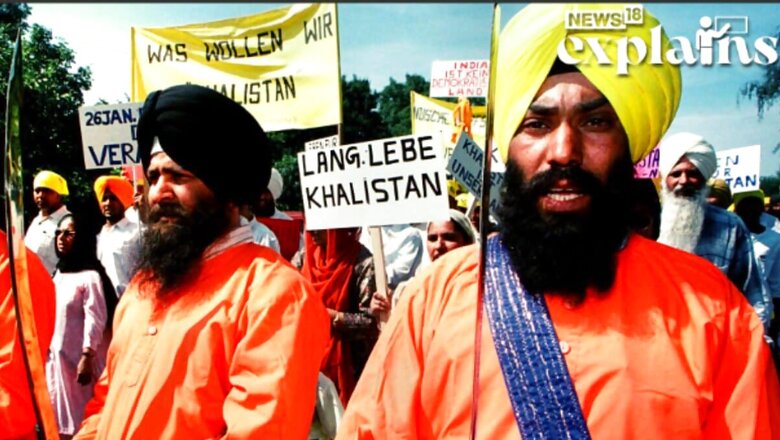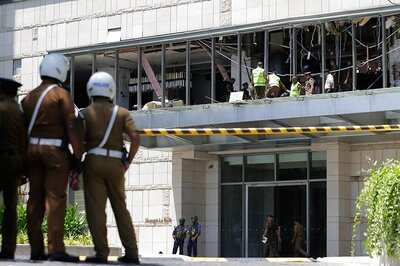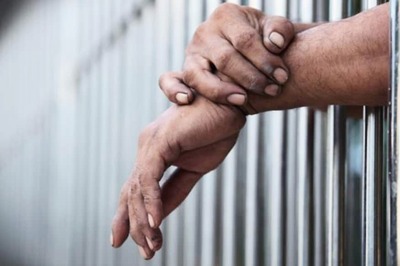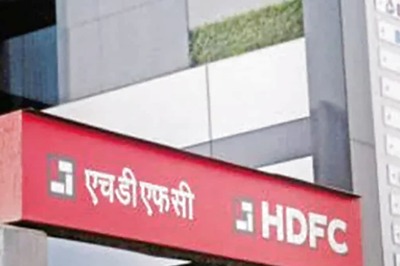
views
The Punjab government has extended the suspension of mobile internet and SMS services till Monday noon, even as the hunt for radical Sikh preacher and Khalistan sympathiser Amritpal Singh continued. The state authorities had on Saturday suspended the internet and SMS services till Sunday noon.
The police earlier said they will soon arrest the fugitive preacher. The broadband services are not being suspended so that banking facilities, hospital services and other essential services are not disrupted, the order issued by the additional chief secretary said.
Talking to reporters near Nakodar in Jalandhar late Saturday night, Jalandhar Police Commissioner Kuldeep Sinhh Chahal had said, Amritpal Singh is now a fugitive and we are looking for him and we will soon arrest him.” He also said that two vehicles belonging to the preacher had also been seized.
The Punjab government on Saturday launched a major crackdown against Amritpal, with the police arresting 78 members of an outfit headed by him, officials said.
The elusive preacher, however, gave the police a slip and escaped their dragnet when his cavalcade was intercepted in Jalandhar district, even as authorities stepped up security at several places in the northern state.
Amid the developments, let’s understand what the Khalistani movement is:
The Khalistan movement is a Sikh separatist movement that seeks to establish a sovereign state in the Punjab region called Khalistan (‘Land of the Khalsa’), according to reports.
The proposed state would be made up of land that currently forms Punjab, India and Punjab, Pakistan, with Lahore as its capital, and would be located in the past geographical region of Punjab, where the Khalsa Empire was once established.
Since the separatist movement gained traction in the 1980s, Khalistan’s territorial ambitions have included Chandigarh, sections of Indian Punjab, including the entirety of North India, and some parts of western India.
How It Started
Gur Gobind Singh’s declaration of the Khalsa in 1699, and the religio-political vision that accompanied it, fueled the Sikh imagination with the belief that it was their God-given right to rule Punjab, Britannica explains in its report on how the Khalistani movement started.
Sikh forces captured Sirhind, the most powerful Mughal administrative centre between Delhi and Lahore, in 1710, led by Band Singh Bahdur, and established a capital in nearby Mukhlispur (“City of the Purified”). They minted coins, created an official seal, and issued letters of command invoking God and the Gurs’ authority. At the time, the belief that “the Khalsas shall rule” was formally added to Sikh liturgical prayer, the report said.
Although the ‘Khalsa Raj’ under Band Singh was short-lived, the concept was realised in the early 19th century in the form of Maharaja Ranjit Singh’s kingdom (1780–1839). Though the Khalsa Raj’s subsequent rapid decline and eventual loss to the British (1849) was a painful experience, it did not extinguish many Sikhs’ hope that the Khalsa Raj would return in some form.
The concept of an independent Sikh state was prominent in the lengthy negotiations that preceded the partition of Punjab in 1947. The Sikh population’s numerical weakness in comparison to other residents of Punjab rendered this an unviable proposition, but it has reappeared in various forms since, the report explains.
For a decade in the 1970s and 1980s, a violent secessionist movement to create Khalistan paralysed the Punjab. And it reached its pinnacle in the late 1990s, after which the insurgency petered out and the movement failed to achieve its goal for a variety of reasons, including a heavy police crackdown on separatists, factional infighting, and disillusionment.
There is some support within India and among the Sikh diaspora, with annual protests in memory of those killed during Operation Blue Star.
Police in Punjab arrested several militant groups in early 2018. Former Punjab Chief Minister Amarinder Singh claimed that recent extremism is being supported by Pakistan’s Inter-Services Intelligence (ISI) and “Khalistani sympathisers” in Canada, Italy, and the United Kingdom.
What is Referendum 2020
The unofficial “referendum” is a voting exercise organised across several countries by the US-based Sikhs for Justice (SFJ) organisation, which was banned in India in 2019 for “espousing secessionism and militant activities”.
The referendum seeks to forge an agreement among Sikh communities to establish Khalistan, a separate homeland within India. It is generally proposed that this be accomplished by carving out the Indian state of Punjab, the country’s only Sikh-majority state. The campaign group says it would then approach the UN and other international human rights bodies with the demand to re-establish “Punjab as a nation state”.
The SFJ was founded in 2007 and is led by Gurpatwant Singh Pannun, a Panjab University law graduate who works as an attorney in the United States, according to a report by the Independent.
The group first announced in 2018 that it would hold an unofficial voting exercise, at the time dubbed “Referendum 2020”, across several countries with sizeable Sikh diasporas, with the aim to “liberate Punjab from Indian occupation”.
“The SFJ announced in its London Declaration [in August 2018] the first ever non-binding referendum among the global Sikh community on the question of secession from India and re-establishing Punjab as an independent country,” according to the SFJ website.
It stated that the referendum would be held in Punjab, as well as major cities in North America, Europe, Australia, New Zealand, Malaysia, the Philippines, Singapore, Kenya, and the Middle East.
According to Indian authorities in Punjab, SFJ and the “Referendum 2020” campaign are being promoted and funded in Pakistan in order to destabilise India. As evidence, intelligence agencies in India have stated that the SFJ website shares its domain with a website based in Karachi.
With inputs from IANS, PTI
This report was originally published on January 30, 2023
Read all the Latest Explainers here


















Comments
0 comment